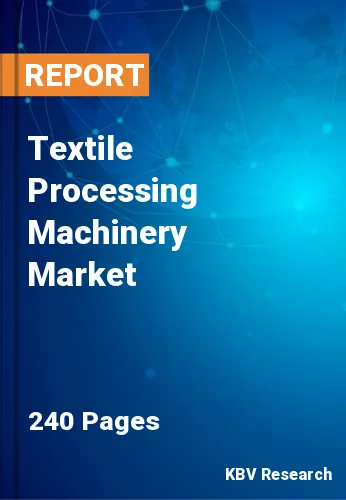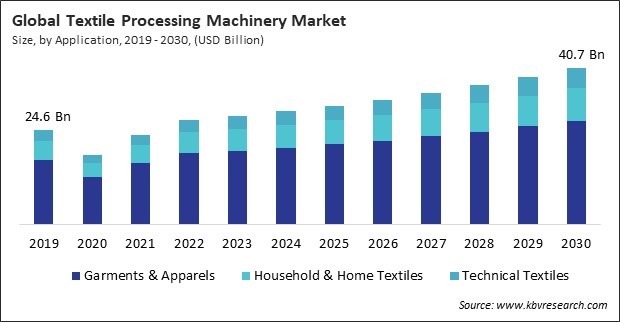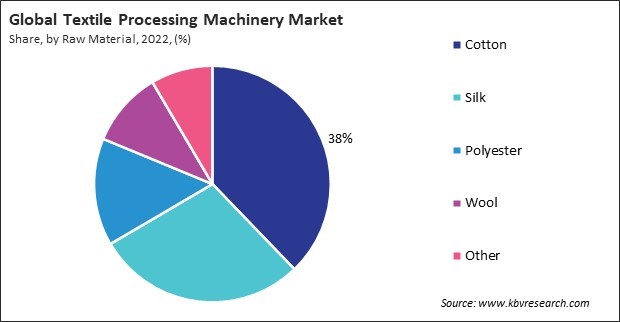
The Global Textile Processing Machinery Market size is expected to reach $40.7 billion by 2030, rising at a market growth of 5.3% CAGR during the forecast period.
Washing machines play a crucial role in textile production by cleaning and preparing textiles for further processing. As such, the washing machine segment would procure nearly 8% of the total market share by 2030. With technological advancements, modern washing machines offer increased efficiency, faster cycle times, and higher productivity. Textile manufacturers seek washing machines that can handle larger loads, reduce processing times, and improve overall throughput to meet growing production demands.

Technical textiles and nonwoven fabrics find applications in various industries such as automotive, healthcare, construction, geotextiles, filtration, and protective clothing. These textiles are used for reinforcement, insulation, filtration, absorption, and barrier protection, driving demand across various sectors. Therefore, the growth of technical textiles and nonwoven fabrics drives the market’s growth. Additionally, fast fashion brands require this machinery capable of high-speed production to meet tight deadlines and rapid product turnover. Likewise, the fast fashion business model emphasizes short lead times from design concept to product delivery, necessitating streamlined and efficient textile processing workflows. Therefore, the growing fast fashion trend is propelling the market’s growth.
However, this machinery is highly specialized and complex, incorporating advanced technologies and precision engineering to perform specific functions. Similarly, the scale of textile production operations significantly impacts the initial investment costs for machinery. Therefore, the high initial investment costs are impeding the market’s growth.
 Drivers
Drivers  Restraints
Restraints  Opportunities
Opportunities  Challenges
Challenges By application, the market is divided into garments & apparels, household & home textiles, and technical textiles. The household & home textiles segment procured a 20% revenue share in the market in 2022. Trends influence the demand for household textiles in home renovation and redecoration as consumers seek to update their living spaces periodically. With changing interior design trends and lifestyle preferences, there is a continuous demand for new and innovative textile products that reflect current styles and themes.
On the basis of raw material, the market is segmented into cotton, polyester, wool, silk, and others. In 2022, the polyester segment attained a 15% revenue share in the market. Technological advancements in polyester production and processing have led to the development of advanced polyester fibers with enhanced properties and functionalities. Innovations such as microfiber polyester, recycled polyester (rPET), and performance-enhancing additives enable manufacturers to produce high-quality polyester textiles for diverse applications.

Based on process, the market is divided into washing machine, bleaching & dyeing machines, drying machines, ironing machines & presses, and others. The ironing machines & presses segment attained a 10% revenue share in the market in 2022. These machines provide a uniform fabric finish during the last stage of manufacturing, improving product quality. In addition, ironing and pressing machines are utilized to iron out seams, fold edges, and raise the pile during textile manufacturing.
Free Valuable Insights: Global Textile Processing Machinery Market size to reach USD 40.7 Billion by 2030
Region-wise, the market is analyzed across North America, Europe, Asia Pacific, and LAMEA. In 2022, the Asia Pacific region generated a 40% revenue share in the market. The Asia Pacific region is a global hub for textile manufacturing, with countries such as China, India, Bangladesh, Vietnam, and Pakistan leading the production of textiles and garments. The region benefits from abundant raw materials, skilled labor, and favorable production costs, making it an attractive destination for textile production.
| Report Attribute | Details |
|---|---|
| Market size value in 2022 | USD 27.3 Billion |
| Market size forecast in 2030 | USD 40.7 Billion |
| Base Year | 2022 |
| Historical Period | 2019 to 2021 |
| Forecast Period | 2023 to 2030 |
| Revenue Growth Rate | CAGR of 5.3% from 2023 to 2030 |
| Number of Pages | 240 |
| Number of Tables | 390 |
| Report coverage | Market Trends, Revenue Estimation and Forecast, Segmentation Analysis, Regional and Country Breakdown, Porter’s 5 Forces Analysis, Company Profiling, Companies Strategic Developments, SWOT Analysis, Winning Imperatives |
| Segments covered | Raw Material, Process, Application, Region |
| Country scope |
|
| Companies Included | A.T.E. Private Limited, Trützschler Group SE, VANDEWIELE NV, Rieter Holding Ltd., Lakshmi Machine Works Limited, Murata Machinery, Ltd., LONATI SPA, Tessenderlo Group nv, Mayer & Cie. GmbH & Co. KG and Toyota Industries Corporation |
By Application
By Raw Material
By Process
By Geography
The Market size is projected to reach USD $40.7 billion by 2030.
Increasing fast fashion business model are driving the Market in coming years, however, Challenges related to shortage of skilled labors restraints the growth of the Market.
A.T.E. Private Limited, Trützschler Group SE, VANDEWIELE NV, Rieter Holding Ltd., Lakshmi Machine Works Limited, Murata Machinery, Ltd., LONATI SPA, Tessenderlo Group nv, Mayer & Cie. GmbH & Co. KG and Toyota Industries Corporation
The Cotton segment led the Market by Raw Material in 2022; thereby, achieving a market value of $14.6 billion by 2030.
The Asia Pacific region dominated the Market by Region in 2022, and would continue to be a dominant market till 2030; thereby, achieving a market value of $19 billion by 2030.
Our team of dedicated experts can provide you with attractive expansion opportunities for your business.
